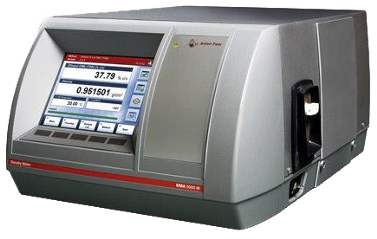Since ethanol is miscible with water in all proportions, it is necessary to determine its strength (or concentration) for commercial purposes such as pricing (on pure ethanol content) and excise duty assessment. Density of an ethanol water solution is an ideal measurement of ethanol content as there is a steady gradation in density from 0.7894 g/ml (pure ethanol at 20 0C) to 0.9982 g/ml for pure water at 20 0C. Density variation with temperature is significant and must be catered for.
The traditional method of density measurement was with appropriate hydrometers and the strength could be determined from density / strength tables, for a given temperature. This method has largely been superseded in favour of much more sophisticated and accurate density meters, also called densitometers.
The principle applied in the most popular instruments relies on the measurement of the frequency of vibration induced in a sample placed in an oscillating glass U tube, compared to that of a material of known density. The induced frequency will be a function of the density of the sample material.
In more detail, the procedure involves the introduction of the sample into a 1 mm glass U tube, avoiding the inclusion of air bubbles. A standard, normally copper inside a similar tube, is positioned alongside the sample tube in a temperature controlled cavity. The two tubes are subjected to vibrational energy and the frequency of oscillation induced in each is measured electronically. An algorithm in the instrument translates the difference in the two frequencies to the density of the sample and the strength (concentration) of the ethanol. This data can be read off a screen, printed out, or transferred to an appropriate electronic data storage system, e.g. a computer.
The recognised test methods are ASTM D4052 and ISO 12185, though many companies develop their own internal test methods based on these.
The company, Anton Paar Gmbh of Austria, developed the above process and then patented it. This make of instrument has thus become the market leader with respect to density measurement of liquids. Numerous models are available to serve industries’ needs. An example is shown on the right.
